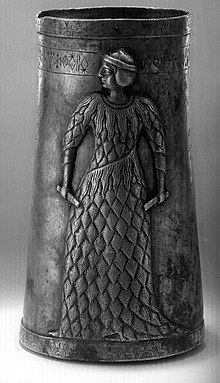Linear Elamite

Linear Elamite is a Bronze Age writing system used in Elam, known from a few monumental inscriptions only. It was used contemporarily with Elamite Cuneiform and likely records the Elamite language.
It was in use for a brief period of time during the last quarter of the 3rd millennium BC. It is often claimed that Linear Elamite is a syllabic writing system derived from the older Proto-Elamite writing system, although this has not been proven. Linear Elamite has not been deciphered, in spite of several attempts, most notably those of Walther Hinz and Piero Meriggi.
There are only 22 known documents in Linear Elamite; they are identified by letters A-V (Hinz, 1969, pp. 11–44; Andre‚ and Salvini, 1989, pp. 58–61); of these, 19 are on stone and clay objects excavated in the acropolis at Susa (now kept in the Louvre in Paris).
The most important longer texts, partly bilingual, appear in monumental contexts. They are engraved on large stone sculptures, including a statue of the goddess Narunte (I), the "table au lion" (A), and large votive boulders (B, D), as well as on a series of steps (F, G, H, U) from a monumental stone stairway, where they alternated with steps bearing texts with Akkadian titles of Puzur-Inšušinak. A unique find is item Q, a silver vase with a single line of perfectly executed text, kept in the Tehran Museum. There are also a few texts on baked-clay cones (J, K, L), a clay disk (M), and clay tablets (N, O, R). Some objects (A, I, C) include both Linear Elamite and Akkadian cuneiform inscriptions. The bilingual and bigraphic inscriptions of the monumental stairway as a whole, and the votive boulder B have inspired the first attempts at decipherment of Linear Elamite (Bork, 1905, 1924; Frank, 1912).
References
- B. Andre‚ and M. Salvini, "Réflexions sur Puzur-Inšušinak," Iranica Antiqua 24, 1989, pp. 53–72.
- F. Bork, "Zur protoelamischen Schrift," OLZ 8, 1905, pp. 323–30.
- F. Bork, Die Strichinschriften von Susa, Königsberg, 1924.
- C. Frank, Zur Entzifferung der altelamischen Inschriften, Berlin, 1912.
- W. Hinz, "Zur Entzifferung der elamischen Strichinschrift," Iranica Antiqua 2, 1962, pp. 1–21.
- P. Meriggi, La scrittura proto-elamica, pt. 1, Rome, 1971.
External links
- Linear-Elamite on CDLI Wiki: http://cdli.ox.ac.uk/wiki/doku.php?id=linear-elamite
- http://www.ancientscripts.com/elamite.html
